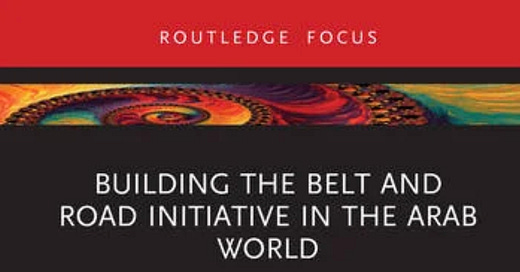New book alert! Building the Belt and Road Initiative in the Arab World: China's Middle East Math
My new book is coming out this week. The landing page is active and it’s available for pre-order, with shipping starting on the 4th. It’s always a fun feeling, but being on vacation I’m not really in book promotion mode right now. I suspect that once I’m back in the Emirates and everyone’s back to work you’ll find lots of shameless self promotion on social media and book talks online. In the meantime, a short post.
The book is called Building the Belt and Road Initiative in the Arab World: China's Middle East Math. I have a hard time with titles, as you’ve probably guessed if you’ve seen my other books, all of which have very generic titles. I liked ‘Middle East Math’ as a hook, but didn’t think anyone would get the reference, so the BRI on the front end is meant to let everyone know that it’s got a political economy angle.
So why the math? In 2014 Beijing hosted the China-Arab States Cooperation Forum, and Xi Jinping gave the welcoming address. In it, he introduced the 1+2+3 Cooperation Pattern as a means of deepening relations between China and Arab countries. In this equation, each number represents a different priority sector. 1 is hydrocarbons, 2 represents trade and investement and infrastructure construction, and 3 is nuclear energy, renewable energy, and space satellites.
A bit of context. This was in June 2014. In September 2013 Xi gave a speech at Nazerbayev University in Kazakhstan where he introduced the Silk Road Economic Belt, with a focus on China-Central Asia. The following month in Jakarta he addressed Indonesia’s Parliament and rolled out the 21st Century Maritime Silk Road, focusing on ASEAN. The two initiatives were formally endorsed by the Party as One Belt One Road in November 2014, and eventually got rebranded in English as the Belt and Road Initiative.
That the 1+2+3 came out 7 months later is relevant. All of these initiatives were meant to give a framework for a more active Chinese foreign policy, centered primarily on economic engagement. While Central Asia and ASEAN are clearly more important to China, the 1+2+3 was an indicator that the Middle East had grown in significance to the Party.
So the book looks at each sector in the equation, showing which countries, sub-regions, and industries are been successful or not. I think it offers a useful way of understanding which countries are more or less important to Beijing, which makes it useful in predicting what we should be looking at in the near-term.
Finally, I know the book is overpriced. That’s the nature of academic publishing. The hard cover run is meant to get purchased by university libraries, and the soft cover should be out relatively soon and have a more reasonable price. If you’re at a university, please pester your acquisitions desk and get them to pick up several copies.
If you have a podcast, webinar series, book talk platform and are interested, please get in touch.





Congrats the new book 🙌